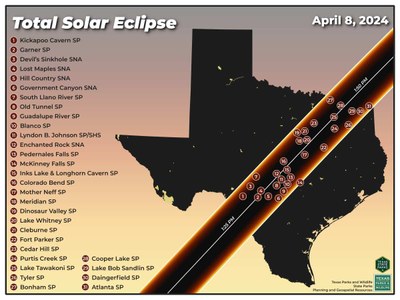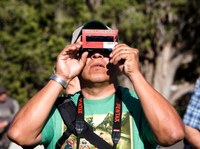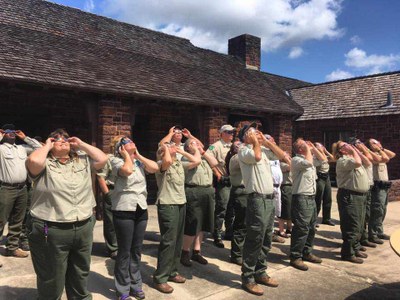Eclipse Viewing
A total solar eclipse is coming to Texas!
What’s an Eclipse?
A solar eclipse occurs when the sun, moon and Earth are lined up in space, with the moon between the earth and the sun.
Total eclipse – Monday, April 8, 2024
During the total eclipse on Monday, April 8, 2024, the moon will blot out the entire sun. For a few minutes, it will look and feel like twilight. You will be able to see this rare event along a line across Texas from Del Rio to Texarkana.
What to Expect
The moon will start to block the sun around noon on April 8. Totality will begin at 1:30 p.m. near Del Rio and trace a line northeast across Texas.
Totality will last from a few seconds to about 4.5 minutes depending on where you are along the path. Only those in the path of totality will get the full eclipse experience.
You will see a partial solar eclipse before and after the time of greatest coverage. If you’re outside of the eclipse’s path of totality, you will see a partial eclipse.
These parks are in the path of totality for the April eclipse:

- Click to see a larger view.
- Atlanta (sold out)
- Blanco (sold out)
- Bonham (sold out)
- Cedar Hill
- Cleburne (sold out)
- Colorado Bend (sold out)
- Cooper (sold out)
- Daingerfield (sold out)
- Devil's Sinkhole (limited capacity, first-come, first served)
- Dinosaur Valley (sold out)
- Enchanted Rock (sold out)
- Fort Parker (sold out)
- Garner (sold out)
- Government Canyon (sold out)
- Guadalupe River (sold out)
- Hill Country (sold out)
- Inks Lake & Longhorn Cavern (sold out)
- Kickapoo Cavern (sold out)
- Lake Bob Sandlin (sold out)
- Lake Tawakoni (sold out)
- Lake Whitney (sold out)
- Lost Maples (sold out)
- Lyndon B. Johnson (limited capacity, first-come, first served)
- McKinney Falls (sold out)
- Meridian (sold out)
- Mother Neff (sold out)
- Old Tunnel (limited capacity, first-come, first served)
- Pedernales Falls (sold out)
- Purtis Creek (sold out)
- South Llano River (sold out)
- Tyler
A partial eclipse will be visible in all other state parks.
How to See the Eclipse
 Solar eclipses are magical experiences. Ensure you have a memorable day by planning.
Solar eclipses are magical experiences. Ensure you have a memorable day by planning.
First, and most importantly, protect your eyes. Purchase eclipse glasses or use an indirect observation method, like a pinhole viewer.
It’s only safe to look directly at the sun during the few minutes of totality. Otherwise, you’ll need to use eclipse glasses or a pinhole viewer.
Other considerations
- Make a reservation: You won’t be able to enter any of the state parks listed above on eclipse day without a pre-purchased day pass or camping permit. We recommend reserving day passes for any state park on this day, even those not in the path of totality.
- Reserve day passes up to a month before your visit.
- Reserve campsites up to five months before your visit.
- A state park pass does not guarantee your entry!
- Passes are not transferable.
- Come early and stay late: Expect traffic delays across the state. We anticipate visitors from across the state and nation for the eclipse.
- Pack more than a snack: Be sure you have extra food, water and fuel in case of delays.
- Park in designated areas only. Stay off roadways for your safety. Don't park off the pavement unless directed by park staff.
- You may not be able to connect. In some areas of totality, cell phone networks and the internet might be jammed.
- Read through our Eclipse FAQs for more information on viewing the eclipse at one of our parks.



